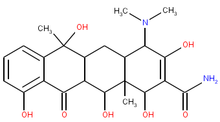Actisite
This article deals with the specific antibiotic called Tetracycline. For the group of antibiotics known as the Tetracyclines, see Tetracycline antibiotics. more...
Tetracycline is an antibiotic produced by the streptomyces bacterium, indicated for use against many bacterial infections. It is commonly used to treat acne. It is sold under the brand names Sumycin®;, Tetracyn®; and Panmycin®, among others. Actisite® is a thread-like fiber form, used in dental applications. It is also used to produce several semi-synthetic derivatives, which together are known as the Tetracycline antibiotic group.
History
Tetracycline was first discovered by Lloyd Conover in the research departments of Pfizer. The patent for Tetracycline was first issued in 1955 (patent number 2,699,054). Tetracycline sparked the development of many chemically altered antibiotics and in doing so has proved to be one of the most important discoveries made in the field of antibiotics.
Mechanism and resistance
Tetracycline inhibits cell growth by inhibiting translation. It binds to the 30S ribosomal subunit and prevents the amino-acyl tRNA from binding to the A site of the ribosome. The binding is reversible in nature.
Cells become resistant to tetracyline by at least two mechanisms: efflux and ribosomal protection. In efflux, a resistance gene encodes a membrane protein that actively pumps tetracycline out of the cell. This is the mechanism of action of the tetracycline resistance gene on the artificial plasmid pBR322. In ribosomal protection, a resistance gene encodes a protein which binds to the ribosome and prevents tetracycline from acting on the ribosome.
Cautions, Contraindications, Side effects
Are as those of the Tetracycline antibiotics group
Indication
Tetracycline's primary use is for the treatment of acne vulgaris and rosacea.
Read more at Wikipedia.org



